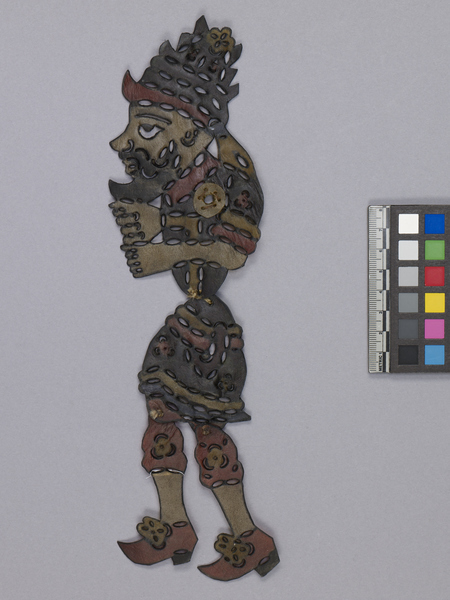Shadow Puppet Item Number: 3084/8 from the MOA: University of British Columbia

Description
Shadow puppet of the main character Karagöz, made of semi-transparent animal skin and a watery paint. The puppet is a bearded man with an elaborate hat holding a flower at top, a collared shirt, short pants and pointed shoes. Arms are raised to chest level, hands clenched. The puppet’s legs and lower body are separate pieces and attached with string ties to create movement. The skin of the object is punctured to show division between the clothing and limbs, and for decoration.
History Of Use
Shadow puppet character, from the Turkish shadow play known as "Karagöz & Hacivat". The play dates back to the Ottoman Empire (c. 1299-1923). It follows the escapades and fights of the two central characters from whom it takes its name. These friends are opposites in many ways: Karagöz (Black Eye) is illiterate and coarse, but well-intentioned, and very funny. Whereas Hacivat is pretentious and conceited, well-spoken and amusing. The plays are full of wit and satire and social and ethnic stereotypes as well as supernatural characters, such as monsters and magicians. Karagöz shadow puppetry was inscribed on UNESCO’s List of the Intangible Cultural Heritage of Humanity in 2009.
Narrative
Collected by the donor in Istanbul in the early 1970s.
Iconographic Meaning
Represents the central character, Karagöz (Black Eye).
Item History
- Made in Turkey before 1970
- Collected in Istanbul, Turkey
- Owned by Rudi Kovanic before October 31, 2014
- Received from Rudi Kovanic (Donor) on October 31, 2014
What
- Name
- Shadow Puppet
- Identification Number
- 3084/8
- Type of Item
- puppet
- Material
- skin, paint and cotton fibre
- Overall
- height 27.7 cm, width 7.8 cm, depth 0.2 cm
Who
- Culture
- Turkish
- Previous Owner
- Rudi Kovanic
- Received from
- Rudi Kovanic (Donor)
Where
- Holding Institution
- MOA: University of British Columbia
- Made in
- Turkey
- Collected in
- Istanbul, Turkey
When
- Creation Date
- before 1970
- Ownership Date
- before October 31, 2014
- Acquisition Date
- on October 31, 2014
Other
- Condition
- good
- Accession Number
- 3084/0008